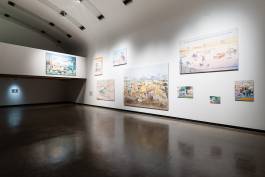Political Populism
2015–2016 Kunsthalle wien Exhibition

© Stephan Wyckoff
Nov 7, 2015 to Feb 7, 2016
Political Populism is the extremely populist title for an exhibition which aims to critically question this phenomenon through artistic means. The exhibition was not designed to present a picture of the cultural and historical development of populist tendencies but instead gathers over twenty international artists’ works and showcases them according to diverse topics. In this way, the exhibition reveals a variety of artistic reactions to different strands of populist argumentation, illustrating how, since the turn of the millennium, the use of pop culture, artistic methods and aesthetics has substantially increased in comparison to earlier years.
The works can be viewed as a commentary on the subject, a subversive second level, an analysis, or a footnote. Above all, they reveal how omnipresent political populism has become.Social media, advertising aesthetics and media production put forward political contents and slogans with a progressive appearance often by the means of artistic, art historical references. Rapping politicians, YouTube clips aimed specifically at young people, TV formats or pop concerts, present political issues and make prejudice socially acceptable – and belong as much to modern media life.The exhibition Political Populism challenges us to comprehend the tensions inherent in a simplified populist worldview and to consider artistic articulations of this phenomenon. Many of the works show the complexity of issues involved and slow down developments which are handled as populist in the public debate. The exhibition questions our relation to populism, and proposes counterarguments to the populist usurpation of important social issues.Edward Snowden and Wikileaks have demonstrated how pervasive the surveillance of citizens has become in the digital age. Following his contribution to the current Venice Biennale, a work which drew considerable attention, Simon Denny’s new work Secret Power Highlighted also deals with documents from the NSA. By referencing leaked secret documents that disclose international surveillance strategies with images and symbols of the power of the state, Denny calls attention to the politics of images and to the changed relation of public and private life. In his works, photographer, journalist, and activist Trevor Paglen also addresses the issue of surveillance by revealing its technical structures, making things visible that are supposed to be invisible – secret prisons, drones, monitoring stations. He persistently looks for traces of even the most secret of things, thereby twisting the logic of the surveillance system.We are all faced with the question of migration and asylum – on a global level. Right- wing slogans fuel insecurity and increase fear which are at once turned into political capital. As a seismograph of societal development, artists are addressing the issue.
In his installation Dog (2015), Erik Van Lieshout demonstrates the consequences the European refugee policy had in the case of Russian rocket scientist and opposition politician Aleksandr Dolmatov. Having sought asylum in the Netherlands, Dolmatov committed suicide in a reception camp in 2013 after his asylum appeal was dismissed. It later transpired that the dismissal was due to a computer error. Artist Flaka Haliti from Kosovo addresses issues of flight and migration and the meaning of borders for mobility and freedom. Bags filled with blue sand stand for uprooting and the loss of possession, both consequences of flight. The blue sand can be seen as a metaphor for the horizon where hope and limitation collide. Ahmet Öğüt deals with eviction through gentrification. For the exhibition, the artist will produce two new installations entitled Nail Houses. The term “nail house” originates from the Chinese neologism and describes buildings whose residents refuse to leave in order to make way for construction or modernization. The buildings are the symbol and result of the individual’s resistance against powerful elites. In addition to images and icons populist argumentation makes use of slogans and simplified rhetorical language. In his performances, Christian Falsnaes tests collective obedience by giving instructions to his audience which surprisingly readily obeys. Falsnaes’ performances are social experiments that demonstrate how easily an initially hesitant audience can, through the artist’s instructions and through group dynamics, be moved to euphoric exuberance. In his work, Lawrence Abu Hamdan also examines linguistic dimensions of political leadership. He is especially interested in which manner the voice represents truth and what significance a lie holds in today’s society. His installation Contra Diction (Speech Against Itself) (2015) deals with the Taqiyya, a form of religious lie in Shia Islam, whereby an individual can deny his faith in the case of danger.
Kunsthalle Wien offered free admission to the exhibition Political Populism as well as to the exhibition’s program.
DIGITAL
Political Populism
A series of talks documenting the exhibition and can be viewed online.
With contributions by Lawrence Abu Hamdan, Simon Denny, Anna Jermolaewa, Johanna Kandl, Erik van Lieshout, Mián Mián, Marcel Odenbach, Ahmet Ögüt and Jun Yang.
Artists: Basel Abbas and Ruanne Abou-Rahme, Lawrence Abu Hamdan, Saâdane Afif, Darren Bader, Keren Cytter, Simon Denny, Christian Falsnaes, Evgeny Granilshchikov, Flaka Haliti, Rosemary Heather, Calla Henkel and Max Pitegoff, Anna Jermolaewa, Johanna Kandl, Erik van Lieshout, Minouk Lim, Goshka Macuga, Jumana Manna, Mián Mián, Marcel Odenbach, Ahmet Öğüt, Trevor Paglen, Hito Steyerl, Jun Yang
Curatorial Assistants: Juliane Bischoff, Eleanor Taylor
Curator: Nicolaus Schafhausen
The foregoing texts and images are provided and copyrighted by: https://kunsthallewien.at












